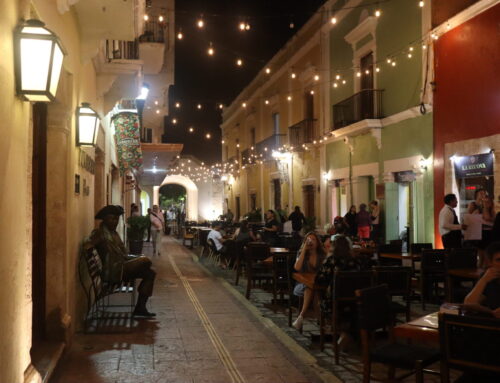Death is universal, and something that society regularly shies away from in fear. Unless you’re Mexican.
Death has always been venerated in Mexico, from the time of the ancient Native civilizations up until our own times. It is simply a part of the country’s cultural identity and every year, on the first day of November, Mexicans all over the country celebrate the Día de Muertos.
The Day of the Dead.

Full view of a “Tapanco” or altar to the dead.
It is during this time that Mexicans believe the dead come back to the realm of the living to call on their relatives. People all over Mexico will visit the graves of their beloved dead and leave offerings of things the person enjoyed during his earthly stay, traditional dances are performed, altars are erected in memory of the dead, prayers are muttered in loud voices, and loving words and moments are remembered fondly… it is a widespread tradition which has been recognized as a UNESCO cultural heritage of humanity. It is a colorful celebration which embodies the Mexican’s attitude regarding death.
As chance would have it, I happened to be traveling through the deserts of northwestern Mexico, staying with native tribes in the region for my “Around the World in 80 Tribes” Project, including the Yaqui and the Mayo tribes which inhabit the desert steppes of Sonora. It was here that I came face to face with their own unique Day of the Dead traditions.
I remember when I first walked into the home of my Yaqui host, Felicitas, and remarked the colorful reed and mesquite altar not three steps from her home. It was decked out with clay plates and jugs set on a flowery cloth. The altar was different to those I had seen in many Mexican homes so I asked the family I was staying with about them. Luckily, my hosts were spiritual healers and had much to say about the netherworldly traditions of their tribe. Later, when I traveled to the small town of Jupare, with the Mayo, I saw the same altar in my host’s backyard, decked out with candles and bottles of beer offered to the spirits of the dead.

A fully-laden altar to the dead. Offerings are made of the relative’s favorite foods.
Both the Yaqui and the Mayo call these altars “Tapancos”. These altars are tall and resemble shoulder height tables. Some say these traditions are a throwback to the times when they used such structures for funeral rites while others assert that these altars are placed high because spirits can glide. They are constructed from reeds and mesquite wood, which are common regional building materials which can be easily harvested. On a close inspection of the altars, one can see the level of care and detail which go into building them; the natives build them with love and respect for their dead.
These altars are decked out with all sorts of goodies to make the spirit of the deceased feel welcome during its earthly visit. Candles are lit, crucifixes and other religious items are placed around the altar, flowers, a symbol of the netherworld, are strewn around, photographs of the dead are placed with care, food is prepared and even alcohol is offered to be drunk by the thirsty spirits during the only time they are allowed to come back and walk among the living. It is, after all, their party; their very own celebration.

Another view of a Yaqui altar to the dead.
These tribes believe the dead come on the first day of November, on the Day of the Dead which is celebrated throughout Mexico. Most of the Yaqui remove their altars the day after, but the Mayo may leave the altar up until the last day of November as they believe that the spirits of the dead linger for a time and then depart back to their spirit homes until they are invited back to stay among the living next year. It is a joyful occasion, during which the spirit of the dead is treated as a visitor to be hosted and remembered.
It is a beautiful tradition, and surely the spirits of the deceased are grateful at being remembered by the living.
Have any traditions with which your own culture remembers the dead? Have any comments? Post them in the section below!



Leave A Comment